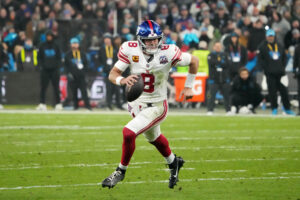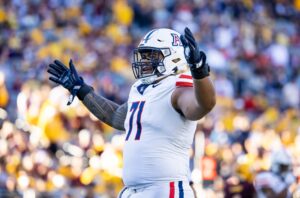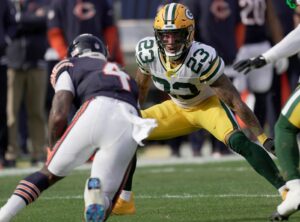Following a historic 2017 draft where the New Orleans Saints added several key starters and contributors, the team entered the 2018 draft with less ammo to work with. Last year, the Saints sat at number 11 in the selection order and made a whopping six picks in the first three rounds. This year they fell to the 27th slot, and had only two selections in the first two days.
Luckily the Saints already added an influx of young talent in 2016 and 2017, and they entered the draft with only a few needs to fill. This gave the Saints front office the confidence to trade up and sacrifice picks for a player they really liked.
In the first round, New Orleans moved up 13 spots to select highly touted edge defender Marcus Davenport. New Orleans paid a high price for Davenport, sending their 2018 and 2019 first round picks and an early 2018 fifth rounder to Green Bay, but if this move pans out it will fill a long-time need at pass rusher.
The rest of the Saints draft was naturally underwhelming after such an aggressive move, but they tactfully added depth to their roster where it was needed. Here’s a full list of the Saints’ selections:
- First round, 14th overall: Marcus Davenport, defensive end, Texas-San Antonio
- Third round, 91st overall: Tre’quan Smith, wide receiver, Central Florida
- Fourth round, 127th overall: Rick Leonard, offensive tackle, Florida State
- Fifth round, 164th overall: Natrell Jamerson, safety, Wisconsin
- Sixth round, 189th overall: Kamrin Moore, cornerback, Boston College
- Sixth round, 201st overall: Boston Scott, running back, Lousiana Tech
- Seventh round, 245th overall: Will Clapp, center, LSU
Saints 2018 draft grade: 7.8/10
New Orleans Saints 2018 NFL Draft Review
The Best Player: Marcus Davenport
This is undoubtedly a huge pick for the Saints organization. With defensive end Alex Okafor coming off an Achilles injury and no other clear pass rusher opposite All-Pro Cameron Jordan, this was the Saints most glaring need entering the draft. In his final season at Texas-San Antonio, Davenport posted 55 total tackles (17.5 for losses), 8.5 sacks, and three forced fumbles. He has great size with room to add build at 6’6″, 264 pounds.
Depending on the source, Davenport was the second or third highest graded edge player behind Bradley Chubb, and he was surely considered by a team at some point in the top 10. He should be worth the risk the Saints took, but it could take time for Davenport to become a more consistent force as he transitions from Conference USA to the NFL. The Saints depth at defensive end looks immediately better now with Davenport in the mix alongside 2017 selections Trey Hendrickson and Al-Quadin Muhammad.
Last year, some felt the Saints should have taken an edge defender like Derek Barnett, who was still available in the first round when the Saints picked Marshon Lattimore. No one doubts the Lattimore selection a year later, and now the Saints should finally get the pass rush help they’ve needed since Junior Galette was released three years ago.
The Head-Scratcher: Rick Leonard
After the departure of versatile offensive lineman Senio Kelemete in the off-season, the Saints had a clear need to replace a player who filled in at every position on the line during his tenure. With that being said, the player they picked late in the fourth round to address this area raises some questions. Leonard only had one full year starting at right tackle after playing defensive end in high school and most of college.
The science of draft projection is largely imperfect (especially for offensive linemen), but several different outlets projected Leonard to go undrafted. Leonard does have great size (6’7″, 311 pounds), but it’s odd to reach for an obscure project player with so much talent still available at that point. Maybe the Saints heard that they weren’t the only team that liked him and didn’t want him to slip away.
Leonard says that he’s willing to play any position on the offensive line, so the Saints may see him as a Kelemete replacement down the road.
The Surprise: Natrell Jamerson
Saints fans might not be too excited about a safety selection when their team already employs a solid trio in Vonn Bell, Marcus Williams, and Kurt Coleman, but Jamerson is an impressive athlete that can help New Orleans in multiple ways. He’s a converted wide receiver who ran a 4.4 40-yard dash at the combine and led all 2018 safety and cornerback prospects with 25 bench press reps.
Jamerson may make the most immediate impact on special teams. He was the Badgers’ starting kick returner as a sophomore and junior, and he returned a kick for a touchdown in 2015. Jamerson is also an experienced blocker and gunner in the return game.
On defense, Jamerson subbed in at cornerback early in his career, playing outside and in the slot. As a senior, he moved into the starting lineup at safety and recorded 51 total tackles (3.5 for losses), 1.5 sacks, two interceptions, and 10 pass breakups. As a team that frequently uses three-safety sets, New Orleans values this kind of versatility in the secondary and needs as much depth there as possible.
The Steal: Will Clapp
Clapp was considered an early day three projection, but New Orleans snagged Clapp late in the seventh round after not drafting a player from nearby LSU since 2010. Clapp led the way for running backs Leonard Fournette and Derrius Guice who went on to become first and second round draft selections, respectively.
Clapp excelled while spending each of his three collegiate seasons at different interior line positions. He received freshman All-American accolades while starting at right guard, and first-team All-SEC honors at left guard as a sophomore and again at center in his final season. There were more athletically gifted centers drafted ahead of him, but Clapp is a proven player from a major program with great potential for a seventh-round pick.
Most Likely to Turn Heads in Training Camp: Tre’Quan Smith
Making only their second pick of the draft at 91st overall, New Orleans still had tight end, offensive line, and linebacker remaining on head coach Sean Payton‘s list of needs. The selection of a wide receiver was somewhat unexpected, but Smith helps solidify a passing game that struggled to convert on third downs last season. 46 of Smith’s 59 catches went for first downs last season, partially due to his exceptional ability to shed tacklers after the catch.
Smith also showed a willingness to go up and fight for catches at UCF, and at 6’2″ he adds even more size to a receiving corps that already has Michael Thomas (6’3″), Cameron Meredith (6’3″), and Brandon Coleman (6’6″). With 4.49 speed, Smith isn’t blazing fast but he gives the Saints another option to stretch the field aside from Ted Ginn Jr, who turned 33 this month. Smith gained 1,171 receiving yards at 19.8 yards per catch and scored 13 touchdowns in 2017.
The Rest
The Saints further bolstered their cornerback depth with Kamrin Moore in the sixth round. He was a three-year starter at cornerback with experience in press coverage, which the Saints employ often. Like Jamerson, Moore will likely become a special teams contributor initially after playing on four special teams units throughout college.
Their other sixth-rounder, Boston Scott won’t overtake starting running backs Mark Ingram and Alvin Kamara anytime soon, but the Saints depth was thin behind their 2017 Pro Bowlers. The 5’6″ Scott says he models his game after former Saint Darren Sproles, and his stat line shows similar big-play potential. He averaged 6.4 yards per rush and 9.6 yards per catch at Louisiana Tech.
Bottom Line
At first glance, this group pales in comparison to the Saints 2017 draft class, but that was destined to be the case with so few early picks. Payton revealed that their main goal was to get Davenport, and that trade talks began days ago to move into the 10-14 range for him. Tight ends were routinely mock-drafted to the Saints in the first round, but pass rusher has been a need for years and adding a likely day one contributor was worth the cost.
New Orleans failed to fill needs at tight end and linebacker, but both position groups appeared to be top-heavy this year. They likely just didn’t see enough value at these positions beyond day one and two. These weren’t crucial needs after the Saints added tight end Ben Watson and linebacker Demario Davis in free agency, but they lack long-term solutions in both areas.
While tight end and linebacker went unaddressed, the Saints doubled down at defensive back and offensive line. Leonard and the defensive backs were taken higher than expected, but Jamerson and Moore should help on special teams, where New Orleans struggled at times last season. After being decimated by injuries in the secondary and the offensive line last season, it made sense to add as much depth in those spots as possible.
The Saints also passed on selecting a quarterback, and they haven’t drafted one since 2015. This position gets increasingly concerning as Drew Brees ages, and they now face a lot of pressure to draft one next year, without a first-round pick at their disposal. Brees signed a two-year extension in March though, and he’s shown little regression thus far.
The Saints appear to be focused on winning now, and while there are still a few holes on the roster, adding a disruptive defensive force like Davenport was the best way to improve their Super Bowl odds.






